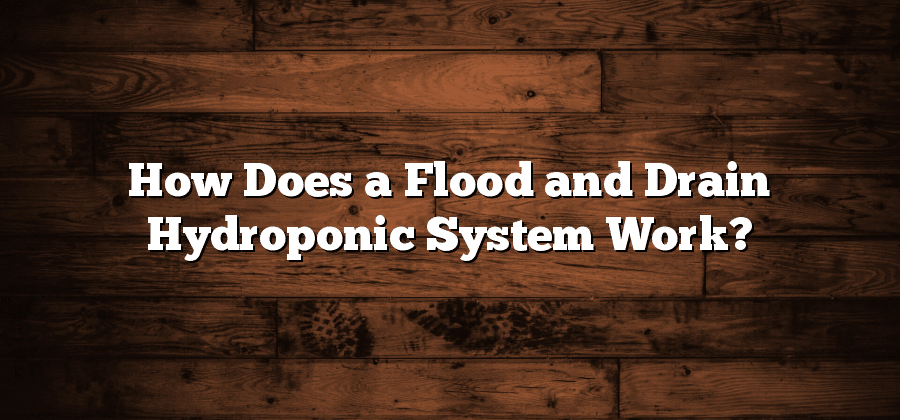– Determining Nutrient Solution Composition
The nutrient solution composition is a critical factor in hydroponic systems as it directly affects plant growth and overall yield. Determining the right combination of nutrients is essential to provide plants with all the necessary elements for healthy development. It is recommended to start with a commercial nutrient mix specifically formulated for hydroponic use. These mixes are often available in concentrated formulas, allowing for easy dilution and customization to meet the specific needs of different plant varieties.
When determining the nutrient solution composition, it is important to consider the stage of plant growth and the specific requirements of the crop. Different nutrients play different roles at different stages, so adjustments may be required to match the changing needs of the plants. The three main macronutrients required by plants are nitrogen (N), phosphorus (P), and potassium (K), commonly referred to as NPK. Micronutrients such as iron (Fe), copper (Cu), and manganese (Mn) are also important in smaller amounts for optimal growth. Carefully following the instructions provided by the nutrient manufacturer and conducting regular pH and EC (electrical conductivity) measurements will help ensure that the nutrient solution composition is balanced and suitable for healthy plant growth.
– Installing and Adjusting the Timer
To ensure successful hydroponic system operation, it is crucial to properly install and adjust the timer. The timer serves as the control mechanism for the nutrient delivery system, regulating the frequency and duration of nutrient solution distribution. Before installation, it is important to carefully read the manufacturer’s instructions to understand the specific requirements for your particular timer model.
Begin by identifying a suitable location for the timer within the hydroponic setup. It should be easily accessible and positioned away from direct contact with water or moisture. Once the location is identified, ensure that the timer is securely mounted using appropriate hardware. This will prevent any accidental movement or damage during operation.
Next, connect the timer to the power source and the nutrient delivery system according to the manufacturer’s instructions. It is important to double-check all connections to ensure they are secure and properly aligned. Once the initial setup is complete, adjust the timer settings as per the requirements of your specific hydroponic system. This may involve setting the desired intervals and duration for nutrient solution distribution. Monitoring the system closely during the initial stages will help in fine-tuning these settings for optimal plant growth and development. By installing and adjusting the timer correctly, you can ensure precise nutrient solution delivery and maintain the overall efficiency of your hydroponic system.
Maintenance and Troubleshooting Tips
Regular maintenance and troubleshooting are essential for the efficient operation of any system. Proper care and attention can help identify and address potential issues before they escalate into major problems. To ensure the longevity and optimal performance of your nutrient solution system, here are a few tips to keep in mind.
Firstly, it is crucial to conduct regular inspections of all system components. This includes checking for any signs of wear and tear or damage. Pay close attention to **pumps**, **tubing**, and **fittings**, as they are more susceptible to wear over time. Inspect the **pH** and **EC** meters for accuracy, ensuring that they are calibrated correctly. Additionally, inspect the **reservoir** for any signs of contamination or sediment buildup. Taking the time to carefully inspect each component will help identify any potential issues, allowing for timely repairs or replacements.
Secondly, cleaning plays a fundamental role in the maintenance of a nutrient solution system. Regularly cleaning the reservoir, pumps, and tubing helps prevent the accumulation of debris and mineral deposits. Start by draining the reservoir completely and then use a gentle cleaning solution to scrub away any residues. Ensure that the cleaning solution is compatible with the materials used in the system to avoid any corrosive damage. Remember to flush the system thoroughly with clean water after cleaning to remove any traces of the cleaning solution. By incorporating regular cleaning into your maintenance routine, you can promote a healthy and optimal growing environment for your plants.
– Regular Cleaning and Inspection
To ensure the smooth operation and optimal performance of your hydroponic system, regular cleaning and inspection are essential. The accumulation of debris, algae, and mineral deposits can hinder the flow of the nutrient solution, impeding its ability to deliver the necessary nutrients to your plants. Therefore, it is crucial to clean the various components of your system on a regular basis.
Start by disconnecting the power source and carefully dismantling the system. Thoroughly clean each component using a mild detergent and a soft brush or sponge. Pay special attention to the reservoir, where sediment can accumulate over time. Use a non-abrasive cloth to wipe away any residue from the pumps, tubes, and fittings. Additionally, inspect the system for any signs of wear or damage, such as cracks or leaks, and promptly address them to prevent further issues.
Once you have cleaned and inspected all the components, reassemble the system and ensure that everything is properly connected and in working order. As part of routine maintenance, it is advised to **check the pH and nutrient levels** in your solution regularly. This allows you to make any necessary adjustments to ensure your plants receive the optimal balance of nutrients. By incorporating regular cleaning and inspection into your hydroponic system maintenance routine, you will enhance its longevity and keep your plants thriving.






